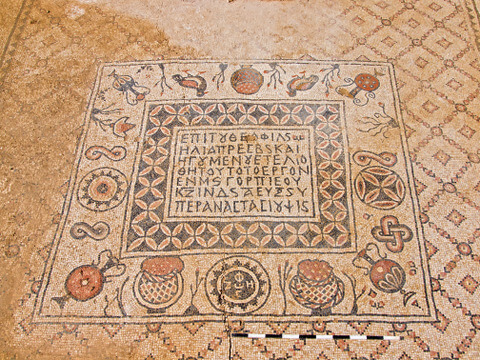Discovered during excavations by the Israel Antiquities Authority before the construction of an interchange by Netibi Israel

In a salvage excavation by the Antiquities Authority conducted for the construction of an interchange on road number 31 at the initiative of the Israel Routes Company at the entrance to the settlement of Hora in the northern Negev, an impressive monastery from the Byzantine period was discovered. The building, whose size is 35 m x 20 m, is divided into halls built on an east-west axis, of which the prayer hall and the 'dining room' stand out, due to the magnificent mosaic carpets in which they were laid.
The prayer hall is paved with a mosaic pattern of brightly colored leaves: blue, red, yellow and green. The "dining room" hall is paved with a colorful mosaic carpet, with models from the plant world, geometric decorations, amphoras, baskets and even a pair of birds.
According to Daniel Varga, the director of the excavation on behalf of the Antiquities Authority, "it seems that this monastery, located near the Byzantine settlement of Horvat Hor, is part of a sequence of monasteries that lie next to a road that connected the Transjordan and the Be'er Sheva valley."
In the mosaic carpets were found four dedicatory inscriptions in the Greek language indicating the names of the heads of the monastery: Eliyahu, Nonus, Salomon and Hilarion, and the dates of the execution of the tiling works in the various halls, which date the monastery to the second half of the sixth century AD. One of the inscriptions is bilingual, where in addition to the Greek language there is a section in the Syriac language.
The entrance to the monastery was from the west. The western wing of the monastery, which is divided into four service rooms, is paved with white mosaic, which was mostly destroyed by landslides following the collapse of the building at the end of the Byzantine period.
In the excavation of the monastery, various pottery assemblages were discovered, including large storage vessels: amphorae and jugs of various types, cooking pots, cauldrons and bowls. Also, many and varied glass vessels belonging to the Byzantine period and coins were discovered at the site. These findings indicate a rich culture in the place.
The excavation site is closed to visitors due to safety issues. The Antiquities Authority, the Israel Routes Company, the Hora Municipality and the Vadi Atir Association intend to reproduce the monastery, on its mosaics, for the nearby Vadi Atir touristic-agricultural project
